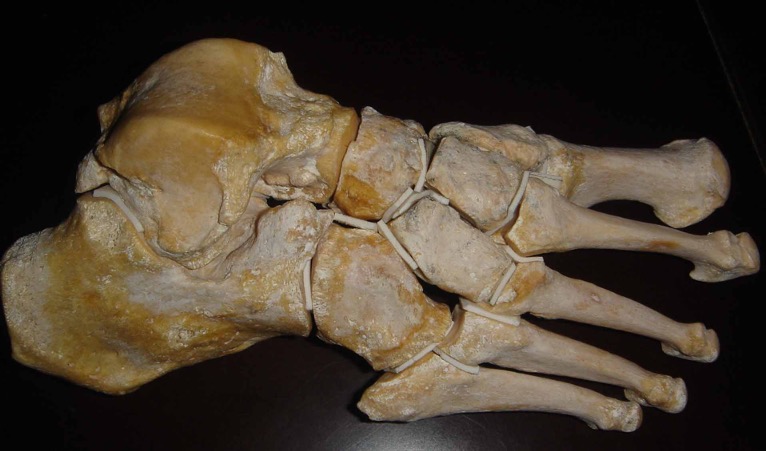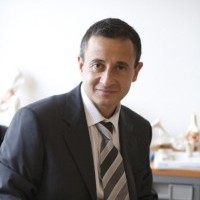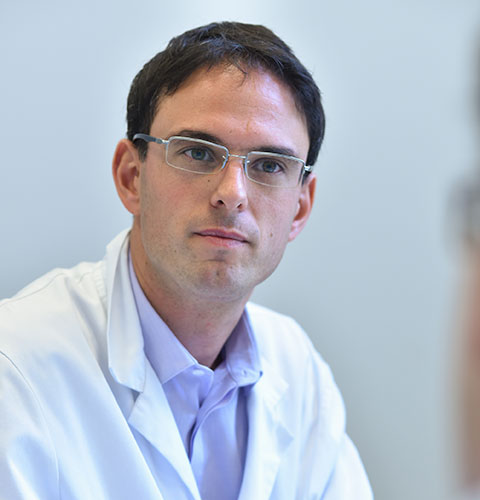Same-day surgery, or outpatient surgery, designates an organisation of care in a way that the entire operative procedures are realized in a same-day hospitalization without staying one night in a care service. It presupposes, of course, the same security rules as a conventional hospitalization. Everything has to be done in a few hours. A much better synchronization of all the actors is needed compared to a classical hospitalization.
The case of Mrs N.
Mrs N., 48-years-old, is consulting her referring physician for important pain in her forefoot, in the region of the big toe. A voluminous “bump” prevents her from shoeing even though she is now only wearing wide sneakers. Her pain sometimes make her renounce to activities she particularly likes (dancing, hiking…), and now paces her daily life.
Her referring physician evokes a hallux valgus, that’s to say a deformation of the forefoot that brings out under the skin the head of one of the foot bones, the first metatarsal. All the measures to limit the symptoms are ineffective (painkillers, anti-inflammatory drugs, wearing wide shoes…), this is why he addresses Mrs N. to the surgeon with a forefoot X-rays.
In consultation, the surgeon examines Mrs N. and confirms the hallux valgus diagnosis. He then explains her the principles of the adapted intervention to the situation, that’s to say the way he considers to cut the bones involved to put them in the right axis.
Conventional hospitalization or outpatient surgery?
The surgeon can propose a classical hospitalization. Mrs N. is thus hospitalized the day before and goes back home the day after surgery.
He could also operate her as an outpatient. In this case, Mrs N. arrives in the morning of the intervention and goes back home the same day. This is organized in relation with the referring physician who knows the patient for a long time. If necessary, he confirms that her life environment and the help brought by her entourage are complying with the outpatient practice. He validates the fact the patient is able to strictly follow postoperative care instructions.
The particular timing and medical care conditions require a perfect synchronization between the different actors: the institution (clinic or hospital), the patient, the anesthetist, and the surgeon.
Back home after surgery, Mrs N. will keep in touch with the medical team, the same way as a classical hospitalization.
It is only at the price of a perfect “choreography” that the same-day surgery can take place.
The role of each actor
Care facility
The clinic is allowed by French administration to practice outpatient surgery, provided that it respects a specific care organization, dedicated to this type of activity:
- Authorization for a precise number of outpatient beds
- Benefits given in ambulatory (so in less than 12 hours) have to be the same as those in a classical hospitalization
- The structure of outpatient surgery must have its own resources in terms of premises, equipment and staff. However, the operating room can be the one in the facility in which the intervention of conventional hospitalisation take place
- The organisation of the outpatient surgery is independent, to welcome the patients and accompanying persons
- Pursuing a defined care protocol
- Monitoring patients during pre and postoperative
- Guaranteeing hygiene and asepsis
- Guaranteeing privacy and dignity respect
The list of specialities allowed for ambulatory surgery is precisely determined. For example stomatology, ophthalmology, ORL… Most of the time, in orthopedics, outpatient surgery concerns the arthroscopy procedure, or foot and hand surgery.
A coordinating doctor takes part to the organization of the medical functioning of the structure, respecting professional and deontological rules. This doctor is usually the physician qualified in anaesthesia.
The facility ensures the permanence and continuity of care, out of the opening hours of the ambulatory surgery structure. The ambulatory surgery service’s particulars are mentioned in the patient’s release bulletin. They allow, at any moment, to contact the doctor on call.
The doctors of ambulatory surgery
The anesthetist
- The preoperative consultation: it takes place several days before the intervention day. The anesthetist eventually prescribes biology test and/or X-rays, depending on the patient’s condition and the type of surgery.
- The anaesthesia in the operating room: it must be perfectly effective but with no excess in the drug administration to limit the side effects prone to prevent the patient from leaving a few hours later. In this context, the resort to exclusively sensitive local anesthesia of the foot is a nearly indispensable asset. On this purpose an anesthetic drug is injected directly in contact with the nerves involved. Not only it avoids pain during the intervention, but it also extends its effect for several hours. It gives time to ensure a pain coverage with traditional oral painkillers.
- The postoperative monitoring: it is ensured in the same way as a classical procedure. The exclusively sensitive local anesthesia permits to alter very little the consciousness of the patient. It has a long-lasting effect allowing usual painkillers to take over when administered precociously. The monitoring is thus clearly lightened. The anesthetist remains available and reachable by the patient after his exit.
The surgeon
- Before surgery, he makes sure it is possible to carry out an outpatient surgery for the type of procedure planned for the patient. At this stage, the general practitioner is a privileged interlocutor, since he knows the patient, his life environment, and thus can help to provide the feasibility of the act.
- Prerequisite: the surgeon needs to master all the required techniques in order to perform surgery in a limited time. This condition is mandatory to ensure quality follow-up.
- On surgery day, the procedure’s organization must be adapted to outpatient surgery. The time factor is the most important parameter to respect, in order to observe the mandatory postoperative monitoring before the exit. This requires a perfect technical mastery and a good synchronisation with the anesthesiologist.
- After surgery, he oversees the patient’s state to authorize his return home, and must stay reachable and available after the exit.
The patient
The patient is one of the actors of the outpatient surgery organization, as well as the care facility and the medical-surgical team. Thus, as the other actors, he has duties, that shall not be neglected. He must understand that:
- His surgery isn’t less important under the pretext that it can be done the same day
- His surgery requires at least the same rigor as if it was realized in a conventional hospitalization
Thus, we often have to explain that a short flight requires exactly the same technical checkups as a long flight, under penalty of precipitated landing…
The patient has to commit oneself to:
- Follow strictly the medical prescriptions received by the anesthetist and the surgeon
- Arrive on time at the care facility on the operation day, since the good functioning depends on it
- Be fasted from midnight the day before
- Plan to be accompanied by a relative for the exit, even if returning home with a taxi
The patient must be conscious of his pathology, the procedure performed, and the possible immediate complications. His entourage must be informed if the patient isn’t able to assess them in all conscious after the surgery. He must commit hisself to inform the medical team at the slightest doubt. He promises for the 24 hours following surgery, to rest, not to drive a car or any potentially dangerous machine, not to take an important decision, and not to drink alcohol. In short a commits to respect all the exit rules of the ambulatory care service.
In conclusion
Outpatient surgery is a true revolution in the patients’ medical care. It allows decreasing stress linked to hospitalization, not to extract the patient from his everyday life context, and to achieve savings to the care system by deleting days of hospitalization.
However, this surgery has many constraints. We must particularly insist on the need for professionalism and a perfect synchronization of the medical and paramedical staff for the fulfilment of tasks, and on a rigorous compliance of the patient to the medical prescriptions.
Only on these conditions this “complex choreography” shall be performed.


